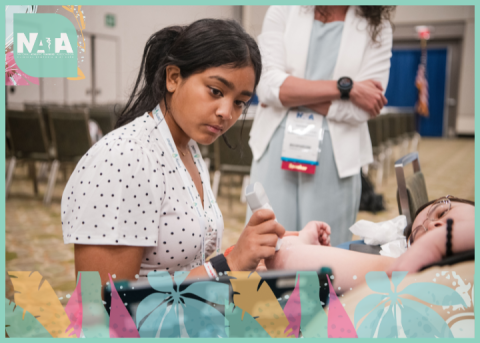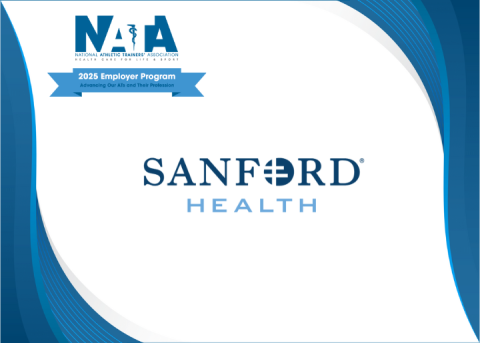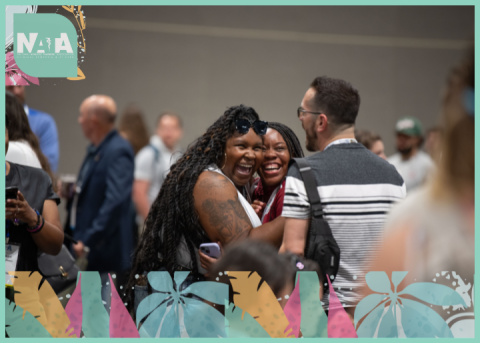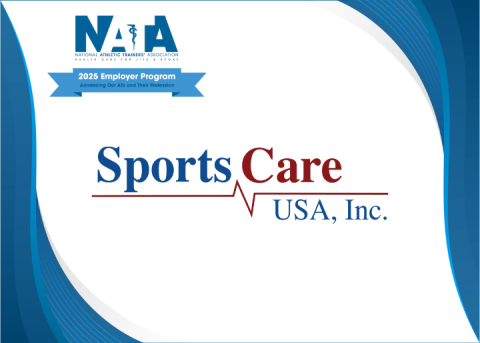
Pictured above: Veronica Ampey, MS, LAT, ATC, Tracye Rawls-Martin, MS, ATC, Akima Abrakata-Dina, MSS, LAT, ATC, René Revis Shingles, PhD, ATC, and LouAnn Jefferson, MEd, ATC, at the 2022 NATA Clinical Symposia & AT Expo.
Athletic training is a profession built on relationships. Just as important as the relationships ATs build with their patients are the ones they build with each other. NATA is often a conduit for these relationships, providing members with opportunities for collaboration, connection and a sense of belonging. This Be NATA blog series will highlight various AT relationships and the role NATA played in these connections.
It happened in Baltimore at the 1988 NATA Clinical Symposia & AT Expo. A group of Black female athletic trainers connected for the first time. That group – which includes René Revis Shingles, PhD, ATC, Akima Abrakata-Dina, MSS, LAT, ATC, Veronica Ampey, MS, LAT, ATC, Patricia Billingslea-Cox, MS, LAT, ATC, and Marsha Grant-Ford, PhD, ATC. LouAnne Jefferson, MEd, ATC, and Tracye Rawls-Martin, MS, ATC, would join the group a few years later. This group of women is still close today and has grown; dubbed “The Sistahood,” it’s now open to women of color athletic trainers.
As NATA has grown, so has its diversity of membership, but at that Baltimore meeting, it was easy for the women to find one another.
“You’re going to see someone from across the room because everybody else is white,” Shingles said “Eventually, you learn the names and figure out who they are. So, you wind up gravitating toward each other.”
“We didn’t become friends immediately,” Ampey said. “But we started making connections and networking.”
Each of the ladies in the group credits the others as a mentor, encouraging one another to step up and take on new roles in NATA and beyond. Shingles said Billingslea-Cox was a part of the Minority Athletic Trainers’ Committee, which inspired her to get involved; Shingles’ involvement encouraged Ampey to step up.
“We each had male mentors, but because of the uniqueness of us being [some of the first] women of color to become athletic trainers, we kind of had to mentor ourselves,” Billingslea-Cox said.
Early in their careers, the women would bounce ideas and struggles off each other, but today the conversation tends more toward retirement plans.
“It’s amazing how everyone has the same issues in the trenches,” Billingslea-Cox said. “You’re talking about working with athletic teams, dealing with difficult athletes, dealing with coaches and administration, it was just a big help back then.”
“We use each other as resources, but these are some of my closest friends,” Ampey said.
They have a group chat just for catching up on things such as birthdays and life events. They send each other Christmas cards. While they are spread out around the country, they try to come together at the NATA convention every year for breakfast. Those breakfasts are how the group has grown.
The Next Generation
Billingslea-Cox is the only member of the original Sistahood, also called the Ogs, who is retired at the moment, though she said she remains active within NATA and other areas. As the other women start their own retirement planning, Shingles said she is looking to pass the torch to younger female Black, and other Women of Color athletic trainers, who she calls the “Young’uns.”
“It's time to pass the torch because some of the issues are the same, but there's some different issues that we didn't deal with,” Shingles said.
The Sistahood has grown from its core group as women were invited to the group’s breakfast and asked to bring a friend. They used to meet up casually before starting their days at the NATA convention, but now the group arranges for a private room at a restaurant to accommodate the size of the gathering, sometimes as many as many as 200. The Sistahood now serves to unite, inspire, empower and celebrate the strength of “sistas in athletic training,” Shingles said.
“I’ve tried to foster deeper connections with the people I mentor,” Ampey said. “I try to demonstrate what our blueprint has been to make these connections. You call on people, whether it’s personal or professional. I trust this group innately, and that’s something that comes from shares experiences both as Black women and women in the profession we’ve chosen.”
Diversity Matters
The women each echoed an important fact about the United States: it’s a richly diverse country and, often, athletic trainers work with students of a different race, ethnicity or religion from themselves.
“Athletic trainers need to know about the needs of the populations they’re dealing with, even if that population looks different from them,” Shingles said. “Then we have issues around the LGBTQIA+ community and the patients we serve who may be in that community. … Diversity is important in a variety of ways from a socioeconomic perspective and the issues that come with wealth inequality. … We’ve got to bring people to the table and give them the opportunity to speak and be heard.”
Billingslea-Cox retired from the Washington, D.C., public school system, where 95% of her patients were students of color.
“It’s important for them to see someone who looks like them, who may have come up like them. It allowed them to say, ‘Hey, maybe I can do that, because that’s someone of color and she’s in a position I could do,’” she said.
Ampey said the face of NATA is different from the 1980s and ’90s. There was a time when she knew every Black AT in the association; but today, she said, there are plenty she hasn’t met. Ampey and Shingles said that while the diversity of the membership has increased over the years, there hasn’t been much movement in the leadership, which is something younger members can help change.
“I tell the Young’uns that we can’t wait to be invited to join a committee,” Shingles said. “We have to step up and volunteer and put ourselves in that position. And we can’t be the change we want to see in NATA if we’re not members of NATA.”
NATA Means More
The women agreed that the Sistahood would not exist without NATA, and that the association has also helped build their careers.
“NATA has allowed me to meet a bunch of women of color, and it’s just been really amazing that the number has increased and everybody is in different pockets and places representing athletic training,” Billingslea-Cox said. “I think the younger or newer members have more opportunities to expand athletic training with organizations like NASA. If NASA had been recruiting when I joined, that would have been an incredible opportunity.”
Shingles said she joined in 1986 for the discount on the certification exam, but “stayed because it was the right thing to do.”
“It was the professional thing to do,” she said. “And then I got involved to be part of the solutions and to make a difference.”
Ampey, who took sports medicine courses at Central Michigan University as electives, joined at the encouragement of her professors. Like Shingles, she stayed to help shape the organization.
“There’s a lot of chatter out there about ‘What does NATA do for me as an athletic trainer? The organization should advocate for us,’” Ampey said. “I tell people all the time that if you’re not a member, you can’t expect them to advocate for you. They need to hear your voice to inspire them to do the things you want them to do. It’s our professional organization and our input is important.”
Be NATA
No matter your setting, you have a home within NATA. Your membership opens the door to problem-solving resources and connects you to our global athletic training community. Be NATA and join or renew your NATA membership by Dec. 31. Don’t let finances get in the way of membership. Contact Member Services through email or by calling 972-532-8897 to learn more about how we can help.





